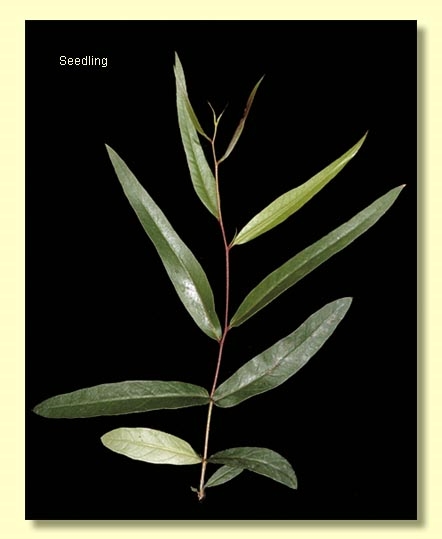Euclid - Online edition
Eucalyptus apiculata
Eucalyptus | Eucalyptus | Eucalyptus | Strictae | Irregulares
T: Berrima, NSW, 10 May 1899, J.J.Fletcher s.n.; syn: K, NSW; Mittagong, NSW, 29 July 1901, J.J.Hook 108; syn: K.
E. laophila L.A.S.Johnson & Blaxell, Telopea 4: 256 (1991). T: NSW, Central Tablelands, Wolgan Gap, 12 April 1953, L.A.S.Johnson s.n.; holo: NSW 27182.
Slender mallee to 6 m tall. Forming a lignotuber.
Bark smooth, cream, grey, brown or green.
Juvenile growth (coppice or field seedlings to 50 cm): stem rounded or slightly square in cross-section, scabrid on lower internodes; juvenile leaves opposite, sessile and amplexicaul for 3 or 4 nodes, then alternate, petiolate, narrowly lanceolate to linear, to 16 cm long, 0.8–2 cm wide, base tapering, glossy, dark green.
Adult leaves alternate, petiole 0.3–1 cm long; blade narrowly falcate to lanceolate to linear, 3.5–11 cm long, 0.3–0.7 cm wide, base tapering evenly to petiole, margin entire, concolorous, glossy, green, venation very acute or side-veins obscure, sparsely reticulate, intramarginal vein well removed from margin, oil glands island.
Inflorescence axillary unbranched, peduncles 0.5–1 cm long, buds 7 per umbel, pedicels 0.3–0.6 cm long. Mature buds obovoid, 0.5–0.8 cm long, 0.4 cm wide, warty, scar absent, operculum conical and apiculate, stamens irregularly flexed, anthers reniform to cordate, versatile, dorsifixed, dehiscing by confluent slits, style long, locules 3 or 4, the placentae each with 2 vertical ovule rows. Flowers white.
Fruit on pedicels 0.2–0.6 cm long, cup-shaped, urceolate, or barrel-shaped, 0.7–1.0 cm long, 0.6–1 cm wide, disc descending, valves 3 or 4, enclosed.
Seeds pale to mid brown, 1–1.8 mm long, pyramidal or obliquely pyramidal, dorsal surface smooth, hilum terminal.
Cultivated seedlings (measured at ca node 10): cotyledons reniform; stems rounded to square in cross-section, densely warty (feel scabrid); leaves sessile, opposite, discolorous, elliptic and held horizontally for lowest ca 4 or 5 nodes, then becoming petiolate, alternate, narrowly lanceolate, 6.5–16 cm long, 0.8–2.2 m wide, base tapering, concolorous, glossy, green.
Flowering has been recorded in January, March, October and December.
A green-leaved mallee ash endemic to New South Wales, of the Central Tablelands on sandstone-derived soils from east of Rylstone south to Berrima.
E. apiculata has linear leaves which distinguish it from E. stricta, which has narrowly lanceolate leaves, and clearly from E. burgessiana, which has lanceolate leaves. The green-leaved mallee ashes grade into each other in leaf dimensions, and each of the three species recognised here, E. apiculata (leaves to 0.7 cm wide), E. stricta (leaves to 1.6 cm wide) and E. burgessiana (leaves to 2.5 cm wide), have synonyms that reflect this gradient but are scarcely applicable taxonomically.
Eucalyptus apiculata belongs in Eucalyptus subgenus Eucalyptus section Eucalyptus series Strictae, because of a combination of characters: mallee habit with smooth bark, alternate, green juvenile leaves, adult leaves held erect and with acute side-veins and little or no visible reticulation, single axillary inflorescences, the buds in clusters of sevens, with buds having only one operculum and reniform anthers, ovules in 2 rows, and ± pyramidal seeds. Within series Strictae, E. apiculata is one of six closely related species all with leaf oil glands that are irregular in outline (subseries Irregulares ); the others are E. dendromorpha (a partly rough-barked tree with clavate buds in sevens); E. triflora (a small ± smooth-barked tree with oblong buds in threes or sevens); E. stricta and E. burgessiana, which differ as described above; and E. langleyi, which has angular branchlets and adult leaves to 5 cm wide.
E. laophila, based on the data presented by Hill & Johnson (1991), scarcely differs from E. apiculata, overlapping almost completely in adult leaf, bud and fruit dimensions. We therefore place it in synonymy.












